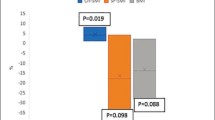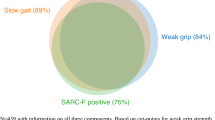Abstract
Sarcopenia is thought to play a major role in the functional impairment that occurs with old age. In clinical practice, sarcopenia is often determined by measuring handgrip strength. Here, we compared the lower limb quadriceps strength to the handgrip strength in their association with health outcomes in older adults in primary care. Our study population consisted of older adults (n = 764, 68.2 % women, median age 83) that participated in the Integrated Systemic Care for Older People (ISCOPE) study. Participants were visited at baseline to measure quadriceps strength and handgrip strength. Data on health outcomes were obtained at baseline and after 12 months (including life satisfaction, disability in daily living, GP contact-time and hospitalization). Quadriceps strength and handgrip strength showed a weak association (β = 0.42 [95 % CI 0.33–0.50]; R 2 = 0.17). Quadriceps strength and handgrip strength were independently associated with health outcomes at baseline, including quality of life, disability in daily living, GP contact-time, hospitalization, and gait speed. Combined weakness of the quadriceps and handgrip distinguished a most vulnerable subpopulation that presented with the poorest health outcomes. At follow-up, handgrip strength showed an association with quality of life (β = 0.05; P = 0.002) and disability in daily living (β = −0.5; P = 0.004). Quadriceps weakness did not further contribute to the prediction of the measured health outcomes. We conclude that quadriceps strength is only moderately associated with handgrip strength in an older population and that the combination of quadriceps strength and handgrip strength measurements may aid in the identification of older adults in primary care with the poorest health outcomes. In the prediction of poor health outcomes, quadriceps strength measurements do not show an added value to the handgrip strength.

Similar content being viewed by others
References
Andrews AW, Thomas MW, Bohannon RW (1996) Normative values for isometric muscle force measurements obtained with hand-held dynamometers. Phys Ther 76:248–259
Bloem BR, Haan J, Lagaay AM et al (1992) Investigation of gait in elderly subjects over 88 years of age. J Geriatr Psychiatry Neurol 5:78–84
Bootsma-van der Wiel A, Gussekloo J, de Craen AJ et al (2001) Disability in the oldest old: "can do" or "do do"? J Am Geriatr Soc 49:909–914
Cantril H. (1966) The Pattern of Human Concerns. Rutgers University Press.
Cawthon PM, Fox KM, Gandra SR et al (2009) Do muscle mass, muscle density, strength, and physical function similarly influence risk of hospitalization in older adults? J Am Geriatr Soc 57:1411–1419
Cruz-Jentoft AJ, Baeyens JP, Bauer JM et al (2010) Sarcopenia: European consensus on definition and diagnosis: report of the European Working Group on Sarcopenia in Older People. Age Ageing 39:412–423
Douma RK, Soer R, Krijnen WP et al (2014) Reference values for isometric muscle force among workers for the Netherlands: a comparison of reference values. BMC Sports Sci Med Rehabil 6:10
EuroQol Group (1990) EuroQol–a new facility for the measurement of health-related quality of life. The EuroQol Group. Health Policy 16:199–208
Femia EE, Zarit SH, Johansson B (1997) Predicting change in activities of daily living: a longitudinal study of the oldest old in Sweden. J Gerontol B Psychol Sci Soc Sci 52:294–302
Fried LP, Tangen CM, Walston J et al (2001) Frailty in older adults: evidence for a phenotype. J Gerontol A Biol Sci Med Sci 56:M146–M156
Giampaoli S, Ferrucci L, Cecchi F et al (1999) Hand-grip strength predicts incident disability in non-disabled older men. Age Ageing 28:283–288
Hairi NN, Cumming RG, Naganathan V et al (2010) Loss of muscle strength, mass (sarcopenia), and quality (specific force) and its relationship with functional limitation and physical disability: the Concord Health and Ageing in Men Project. J Am Geriatr Soc 58:2055–2062
Hanten WP, Chen WY, Austin AA et al (1999) Maximum grip strength in normal subjects from 20 to 64 years of age. J Hand Ther 12:193–200
Kempen GI, Miedema I, Ormel J et al (1996) The assessment of disability with the Groningen Activity Restriction Scale. Conceptual framework and psychometric properties. Soc Sci Med 43:1601–1610
Krabbe PF, Stouthard ME, Essink-Bot ML et al (1999) The effect of adding a cognitive dimension to the EuroQol multiattribute health-status classification system. J Clin Epidemiol 52:293–301
Kwoh CK, Petrick MA, Munin MC (1997) Inter-rater reliability for function and strength measurements in the acute care hospital after elective hip and knee arthroplasty. Arthritis Care Res 10:128–134
Laukkanen P, Heikkinen E, Kauppinen M (1995) Muscle strength and mobility as predictors of survival in 75–84-year-old people. Age Ageing 24:468–473
Lauretani F, Russo CR, Bandinelli S et al (2003) Age-associated changes in skeletal muscles and their effect on mobility: an operational diagnosis of sarcopenia. J Appl Physiol 95:1851–1860
Ling CH, Taekema D, de Craen AJ et al (2010) Handgrip strength and mortality in the oldest old population: the Leiden 85-plus study. CMAJ 182:429–435
Morley JE, Baumgartner RN, Roubenoff R et al (2001) Sarcopenia. J Lab Clin Med 137:231–243
Newman AB, Kupelian V, Visser M et al (2006) Strength, but not muscle mass, is associated with mortality in the health, aging and body composition study cohort. J Gerontol A Biol Sci Med Sci 61:72–77
Poot AJ, den Elzen WP, Blom JW et al (2014) Level of satisfaction of older persons with their general practitioner and practice: role of complexity of health problems. PLoS One 9:e94326
Rantanen T, Era P, Heikkinen E (1994) Maximal isometric strength and mobility among 75-year-old men and women. Age Ageing 23:132–137
Rantanen T, Masaki K, Foley D et al (1998) Grip strength changes over 27 yr in Japanese-American men. J Appl Physiol 85:2047–2053
Rantanen T, Guralnik JM, Ferrucci L et al (2001) Coimpairments as predictors of severe walking disability in older women. J Am Geriatr Soc 49:21–27
Rantanen T, Volpato S, Ferrucci L et al (2003) Handgrip strength and cause-specific and total mortality in older disabled women: exploring the mechanism. J Am Geriatr Soc 51:636–641
Rolland Y, Czerwinski S, Van Abellan KG et al (2008) Sarcopenia: its assessment, etiology, pathogenesis, consequences and future perspectives. J Nutr Health Aging 12:433–450
Schaubert KL, Bohannon RW (2005) Reliability and validity of three strength measures obtained from community-dwelling elderly persons. J Strength Cond Res 19:717–720
Stark T, Walker B, Phillips JK et al (2011) Hand-held dynamometry correlation with the gold standard isokinetic dynamometry: a systematic review. PM R 3:472–479
Taekema DG, Gussekloo J, Maier AB et al (2010) Handgrip strength as a predictor of functional, psychological and social health. A prospective population-based study among the oldest old. Age Ageing 39:331–337
van Houwelingen AH, den Elzen WP, Mooijaart SP et al (2013) Predictive value of a profile of routine blood measurements on mortality in older persons in the general population: the Leiden 85-plus Study. PLoS One 8:e58050
Visser M, Goodpaster BH, Kritchevsky SB et al (2005) Muscle mass, muscle strength, and muscle fat infiltration as predictors of incident mobility limitations in well-functioning older persons. J Gerontol A Biol Sci Med Sci 60:324–333
Acknowledgments
Author contributions
Guarantor: WPJ den Elzen had full access to all of the data in the study and takes responsibility for the integrity of the data and the accuracy of the data analysis.
Study concept and design
J Gussekloo, JW Blom, WPJ den Elzen.
Acquisition of data
OYA Chan, AH van Houwelingen, J Gussekloo, JW Blom, WPJ den Elzen.
Analysis and interpretation of data
OYA Chan, AH van Houwelingen, J Gussekloo, JW Blom, WPJ den Elzen.
Drafting of the manuscript
OYA Chan, WPJ den Elzen.
Critical revision of the manuscript for important intellectual content
OYA Chan, AH van Houwelingen, J Gussekloo, JW Blom, WPJ den Elzen.
Obtained funding
JW Blom and J Gussekloo.
Competing interests
None declared.
Funding
This study was funded by a grant from the Netherlands Organization for Health Research and Development (ZonMw; grant number 60-61900-98-126).
Role of the Sponsor
The sponsor had no role in the design and conduct of the study; collection, management, analysis, and interpretation of the data; and preparation, review, or approval of the manuscript.
Ethical approval
The Medical Ethical Committee of Leiden University Medical Center approved the study in 2009.
Trial registration
Netherlands Trial Register: NTR1946.
Author information
Authors and Affiliations
Corresponding author
About this article
Cite this article
Chan, O.Y.A., van Houwelingen, A.H., Gussekloo, J. et al. Comparison of quadriceps strength and handgrip strength in their association with health outcomes in older adults in primary care. AGE 36, 9714 (2014). https://doi.org/10.1007/s11357-014-9714-4
Received:
Accepted:
Published:
DOI: https://doi.org/10.1007/s11357-014-9714-4




